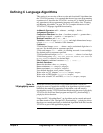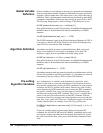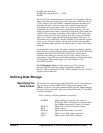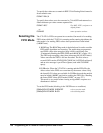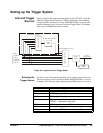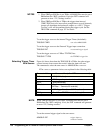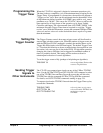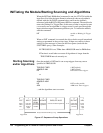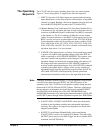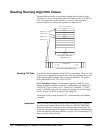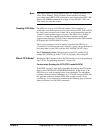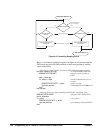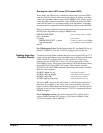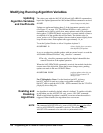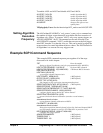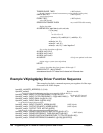
Programming the VT1422A for Data Acquisition and Control 133Chapter 4
The Operating
Sequence
The VT1422A has four major operating phases plus one optional phase.
Figure 4-7 shows these phases. A trigger event starts the sequence:
1. (INPUT): the state of all digital inputs are captured and each analog
input channel that is in the scan list and/or referenced by an algorithm
variable is scanned. Reading values from channels placed in the Scan
List with ROUT:SEQ:DEF are sent to the CVT and/or FIFO.
1A.(Remote Runtime Scan Verification): If a Scan Status Variable (S1xx)
is referenced in any algorithm, this time is used to check the scan list
execution of the Remote Signal Conditioning Unit (RSCU) connected
to the channel xx. The S1xx variable will then take on one of three
values; 0=normal operation, 1=the RSCU is disconnected and 3= the
RSCU scan list was out of synchronization. Each VT1539A SCP has
2 main channels so there are 16 possible scan status variables; S100,
S101, S108, S109, S116, S117, S124, S125, S132, S133, S140, S141,
S148, S149, S156, and S157. If no S1xx variable is referenced in any
algorithm, then phase 1A is not executed.
2. (UPDATE): The update phase is a window of time made large enough
to process all variables and algorithm changes made after INIT. Its
width is specified by ALG:UPDATE:WINDOW. This window is the
only time variables and algorithms can be changed. Variable and
algorithm changes can actually be accepted during other phases, but
the changes don’t take place until an ALG:UPDATE command is
received and the update phase begins. If no ALG:UPDATE command
is pending, the update phase is simply used to accept variable and
algorithm changes from the application program (using ALG:SCAL,
ALG:ARR, ALG:DEF). Data acquired by external specialized
measurement instruments can be sent to the algorithms at this time.
Note Changing algorithm variables requires VT1422A hardware resources that
can only be provided during the INPUT and UPDATE phases of the
operating cycle. The VT1422A does not update variables during the time
between the CALCULATE and OUTPUT phases. Therefore, applications
that are intensive in the update area should consciously extend the INPUT
and UPDATE periods through use of the ALG:UPD:WINDOW and
SAMP:TIME commands or by reducing the time between the CALCULATE
and OUTPUT phases through shorter algorithm loop time. See TRIG:TIMer.
3. (CALCULATE): all INPUT and UPDATE values have been made
available to the algorithm variables and each enabled algorithm is
executed. The results to be output from algorithms are stored in the
Output Channel Buffer.
4. (OUTPUT): each Output Channel Buffer value stored during
(CALCULATE) is sent to its assigned SCP channel. The start of the
OUTPUT phase relative to the Scan Trigger can be set with the SCPI
command ALG:OUTP:DELay.



